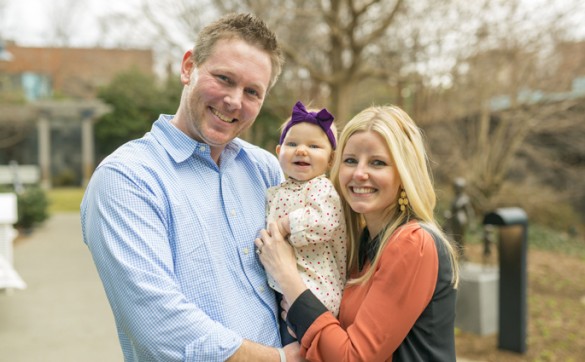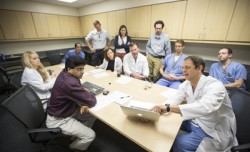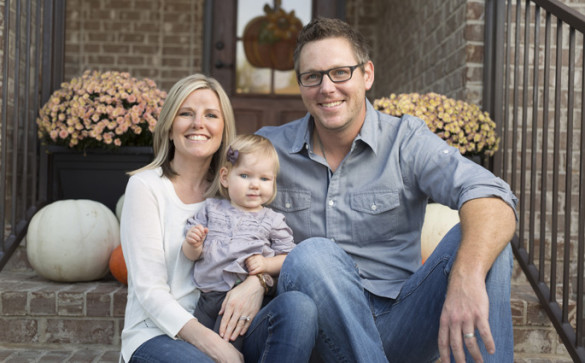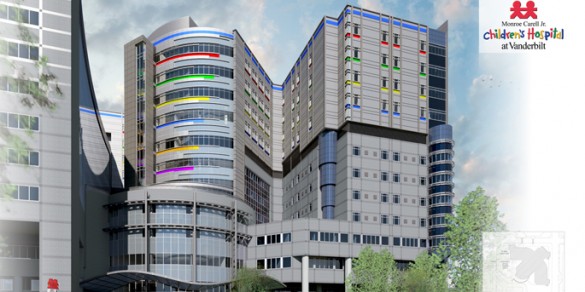
Laura and Justin Burney watched anxiously as the platform holding their infant daughter slowly moved into place inside the CT scanner.
Earlier that evening, the Clarksville couple had rushed their daughter, Brooklyn, to Monroe Carell Jr. Children’s Hospital at Vanderbilt after a pediatrician discovered the child’s head had grown rapidly in a short time.
As images of the 4-week-old’s head came into view on a computer screen, the signs of a significant hemorrhage were clear. Blood was pooling inside Brooklyn’s skull and putting pressure on her brain. Emergency Department physicians urgently paged the hospital’s on-call neurosurgeon.
The infant needed surgery to relieve the pressure and avoid damage to brain tissue. Meanwhile, physicians and nurses worked quickly to prepare the infant for surgery.
“It was like a blur, things were happening so fast,” Laura said, recalling the night.
A second scan found that the source of Brooklyn’s hemorrhage was a ruptured aneurysm. After doctors placed a breathing tube and started an IV line, the Burneys gave their daughter a kiss and told her they loved her.
“I just kept repeating to myself, ‘It’s going to be OK. It’s going to be OK,’” Laura said.
It was just after 1 a.m. when Hong Yu, M.D., assistant professor of Neurological Surgery, took Brooklyn back to the operating room to begin the procedure.
It wasn’t the first time that Brooklyn had faced a serious neurological condition.
A day after she was born, the infant began to experience unusual hiccup-like movements that doctors suspected were seizures. An MRI showed she had suffered a stroke within hours of birth.
Brooklyn spent 10 days in intensive care at an area hospital as doctors watched her carefully for any signs of neurological damage.
When the Burneys were finally able to take their daughter home, Laura and Justin slowly settled into their life as new parents.
The day that Brooklyn turned 1 month old, Laura had spent the morning taking photos of her daughter to mark the milestone, and later the two joined Justin at work for lunch.
That afternoon, as Brooklyn slept in Laura’s arms, the baby appeared to suddenly stop breathing. A moment later, she was breathing again normally. It happened several times, with her lips turning blue before she started breathing again.
Laura anxiously called their pediatrician’s office to ask if they could see Brooklyn immediately.
The after-hours pediatrician, Jennifer Seawell, M.D., measured Brooklyn’s head circumference and found it had increased 2 centimeters since a checkup a week earlier.
The doctor told Laura to take her daughter to Children’s Hospital, which offers nationally ranked medical care for children with complex neurovascular conditions.
Truc M. Le, M.D., assistant professor of Pediatrics and Neurological Surgery, was the on-call intensive care physician at the hospital that night.
Le, who specializes in treating critically ill patients suffering from neurological conditions, is part of a team of doctors across several subspecialties at Children’s Hospital who collaborate on the care of patients with complex neurological conditions.
The team, which includes neurologists, neurosurgeons, neuroradiologists and intensivists, meet regularly to discuss patients in their care and work together to devise treatment plans.
But another benefit of the close collaboration of those doctors has been how quickly they can work together to expedite the care of patients in an emergency — a system that was on full display the night Brooklyn arrived at Children’s Hospital with her parents.
Le was one of the first doctors who learned of Brooklyn’s ruptured aneurysm, and he rushed to the Emergency Department to help prepare the infant for surgery.
By 4:30 a.m. the next morning, Yu finished the procedure, removing the clotted blood inside Brooklyn’s skull and relieving the pressure caused by the hemorrhage.
The infant was placed in Children’s Hospital’s pediatric intensive care unit under Le’s care.
Over the next hour and a half, she remained stable. But shortly after 6 a.m., her blood pressure dropped rapidly.
Le and his team quickly went into action, performing life-saving resuscitation measures to stabilize her.
They discovered that her aneurysm had ruptured again and was bleeding so much that it had caused her heart to stop. It became clear that Brooklyn needed another emergency surgery to clip the aneurysm and stop the bleeding.
“Clipping an aneurysm is a big operation, and you want someone to be as stable as possible during that procedure,” Le said.
At Brooklyn’s bedside, Jay Wellons, M.D., MSPH, professor of Neurological Surgery and Pediatrics, who was just starting his day as the on-call neurosurgeon at Children’s Hospital that morning, determined that time was running out.
His conversation with Laura and Justin was necessarily brief.
“We’ve got to get her to the O.R. now, or she’s not going to make it,” Wellons told them.
While Wellons led the neurosurgical team in the second operation, Le sat down with the couple to explain more about their daughter’s condition and assured them that she was in the best possible hands.
But he also conveyed his grave concerns.
“I really needed them to hear that she’s really, really sick, and we don’t know if she’s going to make it back from the O.R.,” Le said.
There had been no time to perform an angiogram that would have helped them know the precise location of the ruptured artery.
So after the surgeons removed the pooled blood, they methodically searched for the aneurysm, using an operating microscope to carefully explore the length of each vessel hidden in the crevices of the brain’s surface.
Once they found the abnormal outpouching of the aneurysm, it was immediately obvious to them that the artery was weak and poised to rupture again. They isolated the vessel and worked efficiently to place a titanium clip across the base of the aneurysm, effectively sealing it off from circulation.
They next confirmed blood was flowing normally through the rest of the vessel and closed Brooklyn’s incision.
After two weeks in the pediatric intensive care unit, she left the hospital to return home with her family.
The success of Brooklyn’s care at Vanderbilt hinged on the close cooperation of physicians focusing on neurovascular care from across sub-specialties at Children’s Hospital, Wellons said.
“That is a reflection of the system that is set up that allows us to get patients into the O.R. quickly,” Wellons said. “The quicker you get them to the O.R. the better their outcome will be.”
The time discussing patients suffering from neurovascular conditions helps create an environment of collaboration, Wellons said.
“It’s a tremendous benefit to have a group of trusted colleagues who work together well and who can make rapid-fire decisions during the heat of the moment when every second counts,” Wellons said.
Lori Jordan, M.D., Ph.D., assistant professor of Pediatrics and Neurology, a neurologist at the hospital and director of the Pediatric Stroke Program, said that the Burneys’ quick action to seek care for their daughter that day was also key in her successful outcome.
“In adults, the mortality for a ruptured aneurysm is about 50 percent,” Jordan said. “In a tiny baby, who has such a small blood volume, you would think that would decrease the survival to less than 50 percent. The fact that she has survived and recovered is amazing and really wonderful. She’s a delightful child.”
For Laura and Justin, it’s difficult to think about how close they came to losing their daughter, who recently turned 1.
“It almost was like an out-of-body experience,” Laura said. “Sometimes I still don’t think we’ve processed it.”
Brooklyn is doing great, Laura said. Aside from going to physical and occupational therapy to improve some motor skills in her left hand and leg, she has otherwise developed normally.
“There’s probably nothing that we’ll go through in our entire lives scarier than those 24 hours,” Justin added. “We had an amazing experience with Children’s Hospital. We’re so grateful to all the wonderful people who work there. I don’t think people realize how lucky we are to have the Children’s Hospital so close.”
Conference bolsters neurovascular care
A team of doctors at the Monroe Carell Jr. Children’s Hospital at Vanderbilt has established a forum that allows practitioners to come together routinely to discuss how best to care for patients with complex neurovascular conditions.
The doctors from a wide range of subspecialties launched the Neurovascular Conference in 2013 in a bid to improve care and outcomes for patients being treated for brain and spinal conditions.

“The Neurovascular Conference is a perfect example of the multidisciplinary, collaborative atmosphere at Children’s Hospital that facilitates patient care and makes it a great place to work,” said Truc M. Le, M.D., assistant professor of Pediatrics and Neurological Surgery, a critical care physician at the hospital.
The conference grew out of a desire to increase communication between doctors such as neurologists, neurosurgeons, neuroradiologists, intensivists and other subspecialties that treat some of the same patients, said Lori Jordan, M.D. Ph.D., assistant professor of Pediatrics and Neurology, a neurologist at the hospital and director of the Pediatric Stroke Program.
“For decades, there have been examples of similar conferences throughout medicine,” Jordan said.
Neuro-care physicians who participate in the conference wanted to approach their patients with the same collaboration, she said.
The team wrote about their success with the regular neurovascular conference in a paper published earlier this year in the journal Pediatric Neurology. In addition to helping doctors collaborate when treating patients, the conference also helped the team standardize care protocols and improve continuity of care in pediatric neurovascular disease.
Jay Wellons, M.D., MSPH, a professor of Neurological Surgery and Pediatrics, said Children’s Hospital is one of only a handful of North American pediatric hospitals that has such a group.
Reviewing cases as a team allows the physicians to develop a personalized treatment plan informed by practitioners from a variety of specialties, Wellons said.
“Our team has spent time on your child, and this is what our combined experience and expertise recommends,” Wellons said. “That is a strong message to deliver to families.”















